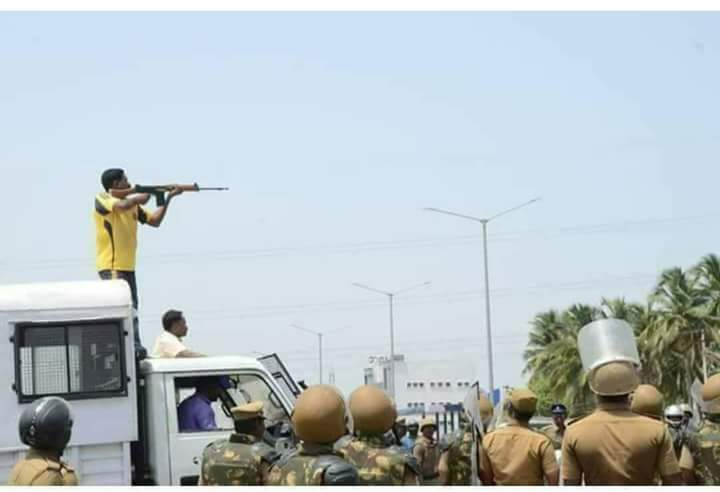How does a protest that went on so peacefully for 99 days, face a violent turn on the 100th day?
Yesterday, was another shameful day in the history of India. Peaceful protestors in Tamil Nadu’s Thoothukudi were subjected to open firing by the police who were over-looking the protest. The incident took place when protestors from various parts of the area gathered to protest against the expansion of the Sterlite Copper plant that is in the possession of Vedanta Limited. The protestors, mostly locals were stopped by barricades put up by the police. The Sterlite plant in Thoothukudi has remained a controversial one with several activists and environmentalists expressing their concern over the threat the project poses to the environment. For long, the local residents have been complaining about the air pollution in the area which could lead to a lot of health issues. Yesterday, people marched ahead breaching the barricades and entering the Collectorate. However, little did they expect that the police force which is supposed to protect the people will open fire indiscriminately on them. As many as 11 people were killed in the protest.
Protests of similar kinds were happening in the state for the last 99 days. So what happened on the 100th day that police had to resort to taking such drastic measures?
What does the police have to say…
The police, who have been on the receiving end of massive backlash had another story to tell.
After the massacre took place and the police went on record, they had something else that they brought to light. The police blamed the mob and said that the protestors became violent during the peaceful protest. According to the police, after the people entered the Collectorate, they set fire to stationary police vehicles and the ones parked in the premise. The police said a group of miscreants was also seen pelting stones at the collector’s office. The Tamil Nadu government in its official response said, “About 20,000 people took out a procession towards the district collectorate and the copper plant with the intention of picketing them, demanding for its permanent closure, and resorted to violence.” The statement further read that charging of batons did not work and thus, orders of open firing were made under “unavoidable circumstances”
Shut down Sterlite Copper plant in Tuticorin immediately: CPM – https://t.co/g4FflrcGO9 | #HWnewsnetwork #Politics
— HW News Hindi (@hwnewsnetwork) May 23, 2018
Why did the Sterlite plant spark a controversy
The controversy surrounding the Sterlite plant dates back to 1994 when the Tamil Nadu Pollution Control Board (TNPCB) issued a No Objection Certificate asking Vedanta to carry out an Environmental Impact Assessment (EIA). Tamil Nadu Pollution Control Board, considering the ecological sensitivity of the Gulf of Mannar Biosphere reserve put a condition that the factory should be located 25 km away from the Gulf of Mannar. However, Sterlite not only failed to submit the EIA but also violated the condition and set up the factory within 14kms radius of Gulf of Mannar.
Soon, the complaints about the pollution from the plant started pouring in with women workers from a nearby factory falling sick and many fainted due to a gas leak.
On August 20, 1997, the staff at Tamil Nadu Electricity Board’s sub-station located across the Sterlite factory complained of headaches, coughing and choking due to smoke stemming from the plant.
The locals also complained that TNPCB was acting in agreement to defend the Sterlite. Soon the protest took the shape of a mass movement. With the activist and environmentalists joining the movement, the matter reached the Supreme Court. In its order dated April 2nd, 2013, the apex court agreed with all accusations against Sterlite but refused to shut down the company.
The apex court also levied a hefty fine of Rs. 100 crores expecting that amount to be a sufficient deterrent.
What could have happened differently in the protest
The protest, primarily peaceful was agitated by a mob of miscreants who did in fact toy with the roots of the whole protest.
In situations like these, where the protestors go out of control, the police force is expected to take up stern enough actions that would not essentially cause any permanent physical damage.
Tamil Nadu Govt constitutes Inquiry Commission on Tuticorin violence – https://t.co/swJsQgcxz9 | #HWnewsnetwork #National
— HW News Hindi (@hwnewsnetwork) May 23, 2018
Under circumstances like that of a violent mob, the police are expected to practice maximum restraint against the protestors. If the protestors do not pay heed to continuous warnings by the police to maintain the “sanctity” of a “peaceful” protest, the officers may resort to the use of water cannons or batons charging on the crowd. If the police are ordered to disperse the crowd, then they are allowed to fire shots in the air. What happened in Tamil Nadu was a sheer act of police brutality. police, in its haste to control the mob, randomly shot at the protestors, rather than identifying the miscreants and taking necessary action against them. The death of 11 people who were only fighting for their right to clean environment could have been avoided.
Yesterday’s incident will go down in history as a very unfortunate event where so many protestors lost their lives.
As an independent media platform, we do not take advertisements from governments and corporate houses. It is you, our readers, who have supported us on our journey to do honest and unbiased journalism. Please contribute, so that we can continue to do the same in future.

